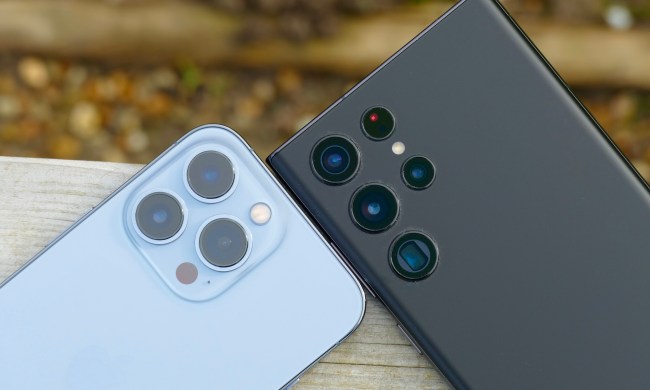At his keynote at this year’s Worldwide Developer Conference (WWDC), Apple CEO Steve Job touted Apple’s latest iPhone 2.0 software, which adds a store for third-party iPhone applications and improves enterprise connectivity, and announced the forthcoming iPhone 3G. Although WWDC is primarily an event for programmers and software developers rather than consumers or mainstream media, in the last few years the keynote has turned into a media event on the level of a Macworld keynote.
Apple iPhone 3G
And Jobs did not disappoint, announcing the iPhone 3G will officially launch in 22 countries on July 11. Physically, the iPhone 3G will sport a full black plastic case that’s thinner at the edges than the first generation iPhone, with metal buttons, the same 480 by 320-pixel multitouch LCD display as the first iPhone, and a flush headphone jack. In a live demonstration, Jobs demonstrated 3G technology downloading data 2.8 times faster than the original iPhone’s EDGE connectivity, but then went on to claim the performance of 3G connectivity comes close to the iPhone’s integrated Wi-Fi, in part because of the iPhone’s software’s performance relative to other platforms. The new iPhone will also feature an integrated GPS receiver (rather than relying on Wi-Fi-based location services), and will offer improved battery life (up to 300 hours of standby, 10 hours of 2G talk time, 5 hours of 3G talk time, 6 hours of browsing, 7 hours of video, or 24 hours of audio).
Apple is also wasting no time rolling out the iPhone 3G: the original iPhone was officially available six countries, but Apple plans to introduce the iPhone 3G in some 70 countries over the next several months (with the biggest omissions apparently being China and Russia).
And perhaps the most interesting part of the iPhone 3G announcement is its price: $199 for an 8 GB edition, and $299 for a 16 GB version, which will also be available in white.
Apple iPhone 2.0 Software
Reviewing the upcoming iPhone 2.0 software, Jobs highlighted improved enterprise connectivity, including Microsoft Exchange support, push email and data, auto-discovery of Exchange servers, and a remote wipe security feature, along with VPN services from Cisco. Apple says some 35 percent of the U.S.’s Fortune 500 companies participated in the iPhone 2.0 beta program—including top commercial banks, major airlines, and other top enterprise customers—and more than 4,000 developers have been accepted into the beta program. According to Jobs, iPhone 2.0 includes everything enterprise users want in an iPhone. The new software also includes a notification service for applications so they can grab a user’s attention with icons or messages without having to run in the background and force users to fiddle with a Windows-like task manager. Apple is also updating the core iPhone applications (including Mail), adding support for Office documents and Apple’s own iWork suite, enabling parental controls for YouTube and the iTunes store, as well as substantially enhancing language support.
However, iPhone 2.0 won’t be all about the enterprise: Apple’s Scott Forstall brought Sega’s Ethan Einhorn on stage to demo Super Monkey Ball for the iPhone (it’ll be $9.99 in the App Store), a fantasy adventure game called Krull from Barcelona-based Digital Legends Entertainment, and Mac game developer Pangea demoed two iPhone games: the physics-based Enigmo and a version of Cro-Mag Rally. Developers also demonstrated free applications for eBay, AP’s Mobile News Network, social locator service loopt, and blogging platform TypePad, as well as applications from Major League Baseball and medical imaging applications from developers MIMVista and Modality.
Apple says the iPhone 2.0 software update will be pushed to iPhone owners in "early July." iPhone owners will get it for free; iPod touch owners can obtain the update for $9.95. Apple will also be supporting ways for enterprises to distribute in-house applications solely to authorized iPhones, as well as "Ad Hoc" distribution that will enable iPhone developers and educators to certify up to 100 iPhones for a particular application.
Apple MobileMe
Apple also unveiled MobileMe, a new "cloud-based" synchronization service billed as "Exchange for the rest of us." MobileMe enables push email, push contacts, push calendar items, and other information with the iPhone, Mac OS X desktop application (like Mail, Address Book, and iCal), with new AJAX-enabled Web applications, and (on the PC side) with Outlook. MobileMe looks to be a replacement for Apple’s current (addled and high-priced .Mac service—which has long been the subject of name-change rumors as Apple’s business expanded to include the iPhone and iPod. MobileMe will be full bidirectional, enabling users to share documents, photos, and other content as well as be notified of changes and updates. Synchronization appears to be very quick: changes in a desktop application are immediately accessible via iPhone, for example. MobileMe will support searching, groups, password-protected access to items, as well as Internet-based storage via Apple’s existing iDisk service. Unfortunately, MobileMe is keeping .Mac’s high price tag: $99/year for 20 GB of online storage, although a free 60-day trial will be available to iPhone owners when Apple released the iPhone 2.0 update.



